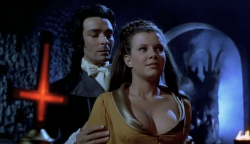Reviews
John Hough
UK, 1971
Credits
Review by Rumsey Taylor
Posted on 17 February 2011
Source Netflix Watch Instantly
Categories Lesbian Vampires
The series of loosely associated films known as the Karnstein Trilogy represents Hammer Films’ strident foray into the domain of the lesbian vampire, a subgenre-defining moment that launched the company from an increasingly musty set of genre franchises into one of the defining producers of exploitation cinema of the 1970s. Based with incrementally increasing artistic license on Sheridan Le Fanu’s highly influential 1872 novella, Carmilla, the films of the trilogy - The Vampire Lovers, Lust for a Vampire, and Twins of Evil - represent the libidinous core of the lesbian vampire subgenre, scripted by Danger: Diabolik and Barbarella contributor (and, later, important trade-unionist) Tudor Gates and boasting a seemingly interminable lineage of blood-thirsty, polyamorous nymphs. Over the next three days, join us as we studiously trace the genealogy of the Karnstein family.
Heretofore in Hammer’s salacious Karnstein trilogy we’ve enjoyed the sultry exploits of Carmilla Karnstein and her various seductions of males and females alike. The first two films - The Vampire Lovers, from 1970, and Lust for a Vampire the following year - feature Hammer staple Ingrid Pitt and Yutte Stensgaard as the aforementioned vampire, anchoring each enterprise as one intent on exploiting the sexy potential of vampire mythology—that is, to posit an alpha villain as a woman who is foremost interested in other women.
Two films into this series, this concept is explored satisfactorily, and from a biographical standpoint successfully christens Hammer Studios’ opportunistic foray into exploitation. But as with all exploitation, merit is measured in excess. Accordingly, the Karnstein trilogy concludes with the only remaining enhancement in the lesbian vampire sub-genre: Twins. Twins… of evil.
The twins in question would be Frieda and Maria Gellhorn, well-to-do and brightly fashionable young women who relocate to Karnstein from the less menacingly-titled Venice. Not before their ephemeral curiosity expires they plop down in their new home, that of their uncle Gustav, and regard the castle that belongs to the town’s namesake, Count Karnstein.
The Count is in this film male, and his castle is a characteristic Hammer set because it is large and ornate and almost totally empty. When he’s inside the castle he’s typically in the middle of some spacious room, his stature of solitude and threat italicized by the space around him. It’s quickly established that he’s an icon of liberalness in a highly puritan location, one valorized by the aforementioned Gustav, who lends the proceedings a skepticism necessary in illustrating the conflict between the old-fashioned fogies and young beautiful vampires that describes so many Hammer films. Because he is portrayed by Peter Cushing - his face contorted forever in doubt - this skepticism is impressively palpable. Gustav, in one of the film’s subplots, heads a team of witchhunters who go about Karnstein on horseback plucking women who engage in immoral activity and burning them at the stake moments later. He is a man bettered by no weapon, for his judgement is so powerful.
When he and Karnstein come face-to-face for the first time - Cushing’s diamond pout transfixing the frame, opposing Karnstein’s masterpiece sideburns and grin - it is an archetypal encounter between the conservative and the liberal. Herewith, and many times before and hence, is exampled Hammer’s subscription to authoritarian resistance. And whatever these films’ potential as horror - none of those I’ve seen have been scary at all - they are clearly fascinated with the villains, and whatever threat they have is manifestly impressive: seducing women, resisting convention.
If it’s not clear at this point that this film is light on the aspect of lesbian vampirism, then perhaps I should remark on what deems it eligible, its relation to the other Karnstein films notwithstanding. Halfway through the film there is no indication that the Gellhorn sisters are anything near evil, but they are clearly discrepant within Karnstein’s close-minded, vaguely misogynist environment. Frieda impulsively exits her bedroom window one night, much to the disapproval of her sister, Maria, and is in short order vampirized by the Count.
So now we have an interesting conflict: a pair of twins, whose emotional identification with the other imbues them with a stalwart trust no other character in the film enjoys, diverged by the corruption of one. And furthermore, Gustav’s renouncement of all things evil is sharply thrown into question once his niece emblematizes that which he staunchly opposes. At this point, late in the film, with the action finally filling the Count’s airy estate, the evil of the title remains unassigned. Gustav is the most disagreeable character in the film, with his morals defined aggressively by his religion, and the Count the most dynamic, likewise the Gellhorn twin who he’s infected. All of these characters are evil in some respect - they are each murderers, for example - but the primary conflict is manifested between the twins, whose preternatural comprehension of each other betrays whatever morals are imbued to them via their politics or upbringing.
It is this aspect that makes Twins of Evil eligible as a lesbian vampire film, only one that’s less suggestive than its forebears and more conceptually innovative. There is subversion aplenty—the Count bedevils a woman early in the film in a sex scene that incorporates metaphoric closeups of fire, lingerie or bedsheets that filter the action, and a climax that involves a masturbated candle (which is, naturally, dripping in hot wax). But at the point this film was released it was preceded by more generous and explicit examples of this subversion, films more dedicated to the exploitation than they are to the intellectual conceit of the lesbian vampire sub-genre. It is in this respect that Twins of Evil is distinguished, for its attempt, however surpassed by its exploitation, at innovation.
More Lesbian Vampires
-

Rape of the Vampire
1968 -

The Vampire Lovers
1970 -

Lust for a Vampire
1971 -

Twins of Evil
1971 -

Vampyros Lesbos
1971 -

Daughters of Darkness
1971 -

The Blood Spattered Bride
1972 -

Vampyres
1974
We don’t do comments anymore, but you may contact us here or find us on Twitter or Facebook.



